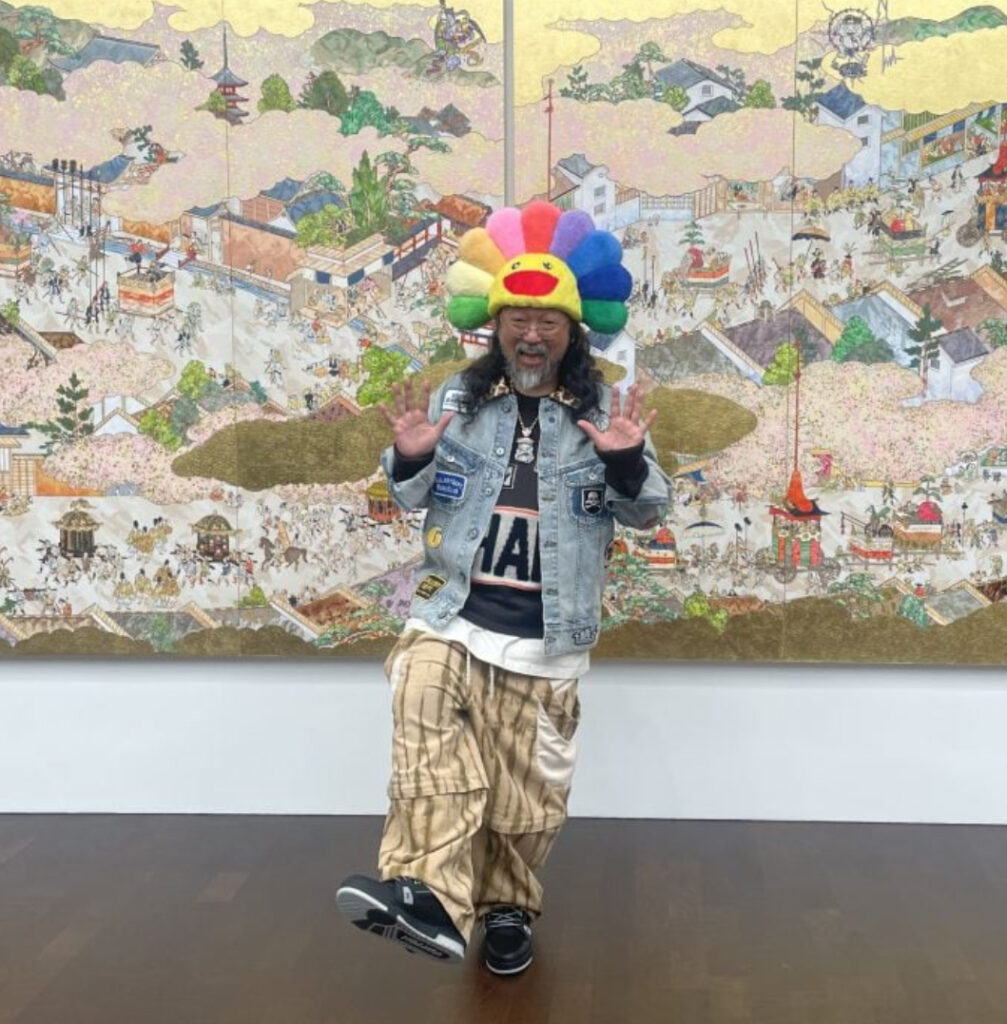For nearly three decades, Takashi Murakami has been a defining figure in contemporary art, blurring the boundaries between traditional Japanese aesthetics and pop culture. Known for his vibrant, candy-colored works that often incorporate anime and manga-inspired motifs, Murakami’s impact is felt far beyond the walls of galleries. His Superflat Manifesto, introduced in the late 1990s, remains a cornerstone of his artistic philosophy, uniting historical Japanese art, manga, anime, and consumer culture into a single, cohesive vision.
But what makes Superflatness so enduring, nearly 25 years after it was first articulated? Why does Murakami remain so captivated by manga, and how does it continue to shape his work and influence global art? This article explores Murakami’s fascination with manga, the evolution of his Superflat Manifesto, and why it continues to set the stage for the future of art.
What Is the Superflat Manifesto?
Murakami’s Superflat Manifesto emerged in the late 1990s as a response to the cultural and economic shifts in post-war Japan. Inspired by traditional Japanese art forms such as Edo-period woodblock prints (ukiyo-e), as well as contemporary manga and anime, Murakami described Superflatness as a blending of high and low culture.
At its core, Superflat is characterized by:
Flattened Perspective: Drawing from traditional Japanese art, Superflat eliminates depth and perspective, creating two-dimensional spaces filled with bold colors and intricate patterns.
Cultural Fusion: Murakami integrates traditional Japanese aesthetics with contemporary pop culture, bridging the gap between history and modernity.
Consumerism as Art: The manifesto embraces consumer culture, transforming everyday objects into collectible art pieces. Murakami’s work often critiques the commercialization of art while celebrating its accessibility.
Murakami’s Manga Obsession
Manga has always been central to Murakami’s creative process. Growing up in post-war Japan, he was immersed in a culture that revered manga as both entertainment and art. This fascination has carried through to his professional life, influencing his visual language, themes, and approach to storytelling.
Manga’s Influence on Murakami’s Art
Visual Style: The flat, graphic quality of manga aligns perfectly with Murakami’s Superflat aesthetic. His works, such as the iconic Mr. DOB and Kaikai Kiki characters, mimic the bold lines and vibrant colors of manga panels.
Narrative Elements: Manga’s episodic storytelling has inspired Murakami’s serialized approach to art, with recurring characters and themes appearing across his works.
Emotional Range: Murakami often draws on the extreme emotional contrasts found in manga—joy, despair, humor, and horror—to create works that resonate on a deeply human level.
From Edo Period to Anime: A Continuum of Flatness
Murakami’s Superflat philosophy is rooted in Japan’s artistic traditions, which have long favored flat, two-dimensional imagery over Western-style depth and perspective.
Traditional Japanese Art
Woodblock Prints: Edo-period prints by artists like Hokusai and Hiroshige emphasized vibrant colors and bold lines, laying the groundwork for Murakami’s visual language.
Emaki Scrolls: Narrative scrolls from the Heian and Kamakura periods used a flattened perspective to depict dynamic, sequential stories, much like modern manga.
The Rise of Manga and Anime
Post-war Japan saw a cultural shift, with manga and anime becoming dominant forms of artistic expression. Visionaries like Osamu Tezuka (Astro Boy) and Hayao Miyazaki (Spirited Away) elevated these mediums to new heights, blending entertainment with profound storytelling. Murakami’s work exists at the intersection of these traditional and contemporary influences, celebrating Japan’s unique visual culture while pushing it into new realms.
Consumer Culture and the Democratization of Art
Murakami’s fascination with manga and anime isn’t purely aesthetic; it also reflects his interest in consumer culture. Manga, like anime and other forms of pop media, is mass-produced and widely accessible—a stark contrast to the exclusivity of fine art.
Art for Everyone
Through Superflat, Murakami challenges the traditional art world’s elitism by embracing the commercial nature of manga and anime. He produces work that can be enjoyed across mediums, from limited-edition prints and sculptures to merchandise and clothing.
Critique and Celebration
While Murakami celebrates the accessibility of manga-inspired art, his work also critiques the commodification of culture. Pieces like 727 and Tan Tan Bo reflect the overwhelming saturation of consumer goods, offering a mirror to Japan’s post-modern identity.
Murakami’s Global Influence
Murakami’s work has transcended Japan’s borders, influencing artists and industries worldwide. His collaboration with brands like Louis Vuitton and musicians like Kanye West has introduced Superflatness to a global audience, proving its relevance far beyond the art world.
Collaborations with Fashion and Music
Louis Vuitton (2002): Murakami reimagined the luxury brand’s iconic monogram, infusing it with his colorful, manga-inspired aesthetic. This partnership redefined the relationship between art and fashion.
Kanye West (2007): Murakami designed the album cover for Graduation, blending hip-hop culture with anime-inspired visuals, creating a cultural touchstone.
Influence on Contemporary Artists
Murakami’s Superflat philosophy has inspired a new generation of artists who blend traditional art forms with digital media, street art, and pop culture. Figures like KAWS and Daniel Arsham credit Murakami as a major influence on their work.
Superflatness in the Digital Age
As we approach the 25th anniversary of the Superflat Manifesto, its principles remain strikingly relevant in the digital age. Social media platforms like Instagram and TikTok have flattened the boundaries between creators and audiences, mirroring Murakami’s vision of a world where high and low culture coexist.
NFTs and Digital Art
Murakami has embraced digital art through NFTs, releasing collections that adapt his Superflat aesthetic to blockchain technology. This move reflects his commitment to exploring new mediums while staying true to his artistic roots.
Why Superflatness Still Rings True
Murakami’s enduring obsession with manga and Superflatness lies in their ability to evolve with the times. By drawing on Japan’s rich artistic traditions while embracing contemporary culture, Superflat continues to resonate in a world that values inclusivity, accessibility, and creativity.
Art as a Mirror
Murakami’s work offers a reflection of society, capturing the beauty, chaos, and contradictions of modern life. His use of manga as a medium for storytelling ensures that his art remains both timely and timeless.
Impression
Nearly 25 years after the introduction of Superflat, Takashi Murakami remains a vital force in contemporary art. His love for manga and commitment to breaking down barriers between high and low culture continue to shape his work and inspire others.
As we look to the future, it’s clear that Murakami’s Superflat philosophy is more than a manifesto—it’s a movement that challenges us to rethink the role of art in a globalized, interconnected world. Whether through traditional mediums or digital innovations, Murakami’s vision will undoubtedly set the stage for generations to come.
No comments yet.







